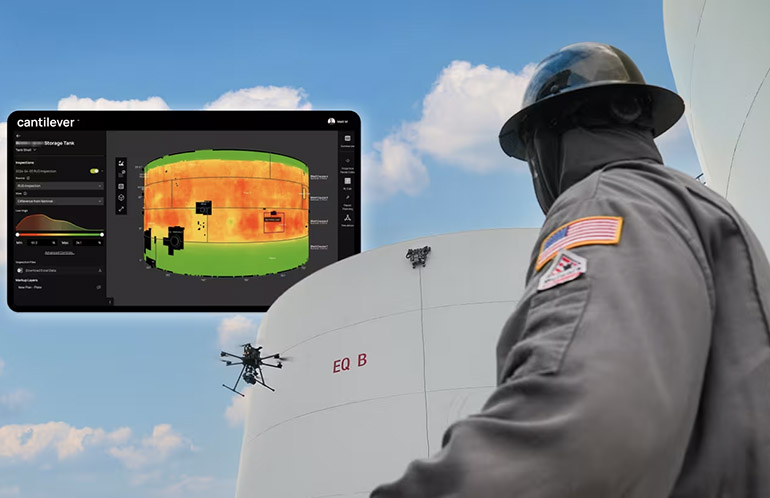|
Listen to this article |

Fulcrum can ensure that Cantilever has high-quality infrastructure data to analyze. Source: Gecko Robotics
Robotic maintenance of large structures and critical infrastructure is only as useful as the data it yields. Gecko Robotics Inc. has announced its Fulcrum software for data acquisition and quality. Its first public use was this week.
The Pittsburgh-based company, best known for its robots that can climb and maintain tanks, has also developed drones and software. It said its Cantilever operating platform uses artificial intelligence and robotics (AIR) for data analysis and to support fast decision-making at scale.
Jake Loosararian, co-founder and CEO, and Jennifer Padgett, engineering manager at Gecko Robotics, explained to The Robot Report how Fulcrum and Cantilever can enable new levels of insights from robotic inspection.
Fulcrum enables data analytics from multiple sources
What is Fulcrum?
Loosararian: Jenn designed and built Fulcrum. Its design is centered around creating an API [application programming interface] for robots.
It’s all in support of our goal for Gecko — to protect critical infrastructure. This requires information about the built world.
Robots armed with different sensors turn the physical world of atoms into bits. The key is ensuring those bits drive useful outcomes.
The sensors on robots and drones can collect a lot of data — how do you determine what’s useful?
Loosararian: We collect so much and different types of information with our robots that climb walls or from fixed sensors. It’s not enough to just gather and post-process this data. We want to get as close to the process as possible.
Fulcrum is specifically built to gather data sets for high-fidelity foundation models. It’s designed not just to ensure quality data from all types of robots and sensors, but also to accelerate our ability to capture data layers for our Cantilever enterprise software.
For example, they can be used to predict when a tank would leak, a bridge collapse, or a naval vessel need to be modernized.
Padgett: We’re building a validation framework with our subject-matter expertise. We’ve collected millions of data points, while humans typically gather data points every square foot or two.
With Fulcrum, we understand the data as you’re collecting it and double-check it. We’ve optimized for inspections of concrete in missile silos, as well as tanks and boilers.
Gecko Robotics offers understanding of infrastructure health
How is Gecko Robotics pivoting from robotics hardware to AI?
Loosararian: We’ve traditionally developed hardware for data collection. Data quality is the starting point.
We’re helping people to understand what their livelihoods are based on by giving a full picture. Inspections affect everything from driving across a bridge to turning on the electricity.
We believe in democratizing data. We can’t build all the robots ourselves, and I recently talked onstage about the potential for humanoid robots like Tesla’s Optimus.
We’ve developed AI and built an ontology to connect things to monitor and maintain infrastructure health. Building and operating critical infrastructure is a matter of global competitiveness.
Padgett: With AI for pre-processing and low-level heuristics on key modules, Gecko can deliver useful data for customers. Fulcrum is really meant to provide higher-level analytics at the edge.
Jake, you mentioned the API and working with other robots. Who are you working with?
Loosararian: We’ve already made partnerships and are vetting a dozen companies for the kinds of tools that will be certified under the Gecko umbrella. We want to onboard as many robots as we can.
At the same time, we’re very skeptical of which robots are actually valuable. As we go to market with the platform, we understand which tools are good for marketing versus actually helping the business.
We’re not interested in research projects; we’re interested in companies that want specific, real-world impacts within 90 days. Right now, there’s a lot of skepticism around hardware and software, but with our robots and AI-powered software, the savings are real.
We’ve built up abstracts for how to interact with certain types of robots, drones, and marine systems. This makes it easy to add; by working them into our communications protocol, we’re language-agnostic.
We’re also interested in new types of sensors and how they can affect outcomes.
Predictive maintenance key to value proposition
What industries can this help?
Loosararian: It’s not one industry; it’s everyone. Infrastructure is huge — from aircraft carriers to mining companies. We’ve got products and services that help them understand the state of their assets.
Right now, we’re focusing on built structures using next-generation IoT [Internet of Things] sensors. With fixed robots, mesh networks, and 5G, we’re imagining beyond that.
Cantilever is already providing data on 500,000 assets, and it’s already making changes in the way customers operate.
We’re constantly being pinged by companies that want us to integrate automated repairs and cleaning, which are important functions to maintaining safety and environmental sustainability.
We want to ensure that we can meet growing demand for things like shipyard maintenance with the growing scarcity of qualified people. Fulcrum has the ability to offer relevant information, changing the standard operating procedures from human-collected data.
So is the goal to apply IoT and AI to spot issues before they become problems?
Loosararian: We can know what the robot is doing, what it should be collecting, and get the analysis. With the life-extension AIR module, we can look at the data layers in concrete, carbon steel, and stainless steel to extend the useful life of critical infrastructure.
Fulcrum is also part of capex [capital expenditure] optimization. Users want to avoid replacing things, having downtime, or suffering from catastrophic failures. They need specific data rather than broad strokes so they don’t have to worry about overpaying to replace something that doesn’t yet need to be replaced.
Another opportunity is process optimization. For example, an oil company needs to understand how a higher sodium concentration in the Gulf of Mexico will impact its assets. That’s built into the Cantilever data pipeline from Fulcrum.

